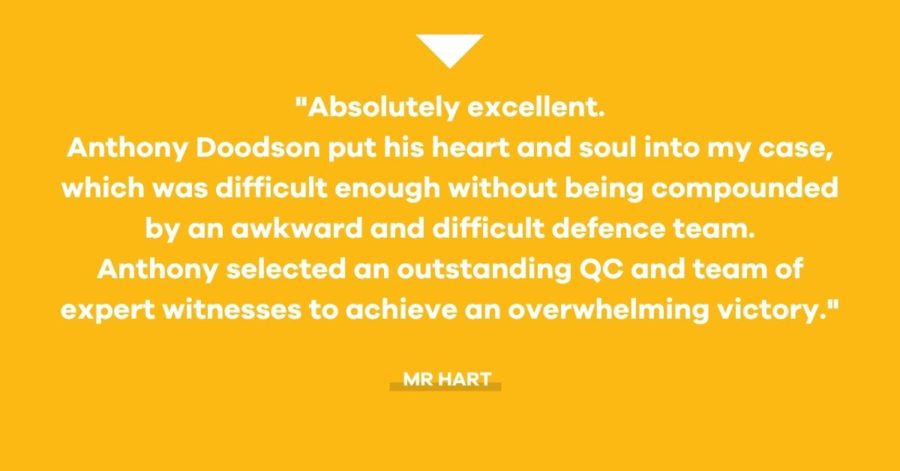
A man who was left fighting for his life after a one in a million allergic reaction to Naproxen following a vehicle collision, has received access to justice and settled he claim for £1.35m to aid to aid his recovery – through the combined effort of Minster Law and 9 Gough Chambers.
Associate Solicitor Anthony Doodson described the case as one of the most challenging in his career, yet ultimately one of the most rewarding. “Mr Hart is one of the most genuine people I have ever met and dealt with his situation stoically and bravely. I am delighted to have helped him succeed on this claim and secure an appropriate level of damages that should help make his life more comfortable going forwards.”
Mr Hart initially suffered soft tissue injuries to his neck, back, shoulders and ankle as a result of a roundabout collision with a lorry. After a visit to his GP, he was prescribed naproxen, an anti-inflammatory medication, to help with those injuries.
Around 3-4 weeks after the accident he became unwell and began experiencing difficulties breathing, so was rushed to James Cook hospital in Teesside.
The hospital initially thought he had pneumonia and treated him with antibiotics, but his condition continued to deteriorate, and doctors looked for other causes of his lung difficulties. As his health progressively got worse, he ended up in a coma for 9 weeks and was close to dying.
Consultants were able to determine he had suffered an allergic reaction to the naproxen medication, which only happens to around 1 in a million people who take this medication.
They eventually tried a strong immune-suppressant medication, and he turned a corner in his recovery.
He was eventually discharged from hospital three months later, although he was left with severe permanent lung damage as a result of this inflammatory reaction.
When he returned home, he had to set up a bedroom in his lounge as he was limited in his walking to about 5 metres.
He was forced to give up his job as an electrical site manager and was very restricted in what he could do both around the home and socially.
He had loved travelling and was not able to do this due to the quote of £3,500 for insurance for one week’s holiday.
Since the early days after his discharge from the hospital, his lung condition did improve to some degree, however, his life is far from normal. He has tried to do his best to have a fulfilling life by working as a volunteer treasurer for his local cricket club.
Much like his recovery, the claim was far from straightforward.
The Defendant Insurance Company disputed the cause of the Claimants lung condition and said they thought he had pneumonia, and this had nothing to do with the accident.
They also obtained surveillance footage of the Claimant helping out at the cricket club and alleged he was fundamentally dishonest and should not get any damages at all.
They would not engage with his legal team provide any assistance in the form of rehabilitation and did not make any real effort to settle the claim.
Civil practitioner at 9 Gough Chambers, Giles Mooney QC, was brought on board to help fight his case.
“This has been a very difficult claim throughout – arguing as we were, that the accident was the causation of a 1 in a million condition – but was made much harder by the 12 days of surveillance taken of our client,” he said.
“The defendant arrived at trial arguing no causation and fundamental dishonesty.”
To counter the potentially damaging surveillance footage from the defence Anthony obtained some video footage of our own of the claimant simply doing things like climbing the stairs, brushing his teeth, and walking along the road where he lives.
In our footage, the Claimant was wearing his oxygen and pulse monitor so it was possible to see what his blood oxygen levels dropped to while doing these activities which was extremely helpful objective evidence in support of his difficulties and lung disability.
Giles said throughout the trial Anthony was brilliant and he had never, in 24 years at the bar, had a solicitor with such an encyclopaedic knowledge of the papers.
“Whenever I asked for anything, he knew exactly where it was,” he said.
“He contributed to the case fantastic preparation, assembled an expert team, provided the counter-surveillance material which the judge was very impressed by and the drafting of the witness statements – all of which contributed to our eventual success.”
The Claimant had experts in the fields of respiratory medicine, psychiatry, care and assistance and accommodation to give oral evidence at the trial.
After two days of the trial HHJ Freedman, a deputy High Court Judge said he could give a preliminary view on the two key issues of the cause of the Claimants lung condition and whether he was fundamentally dishonest or not.
The Judge found in the Claimants favour on both issues and recommended that the defence make offers of settlement to the Claimant.
The Judge concluded as the condition suffered by the Claimant was so rare, the respiratory consultants at the James Cook Hospital would have taken a lot of care with their diagnosis and did save his life, so they were very likely to have been correct in their diagnosis.
On the third day of the trial, the parties reached an agreement to settle the claim for £1,350,000.
Hart said the result of his case was absolutely excellent. “Anthony put his heart and soul into my case which was difficult enough, without being compounded by an awkward and difficult defence team.
“He selected an outstanding QC and team of expert witnesses to achieve an overwhelming victory.”



